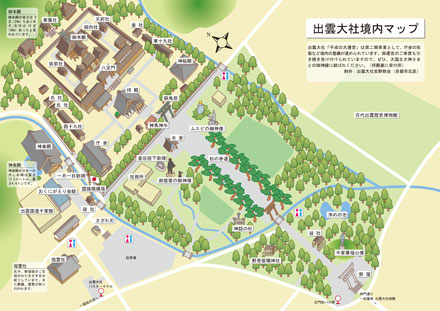Izumo Taisha Tour/ Izumo Taisha Trip


Club Tourism 's Izumo Taisha tour and travel special! With a tour guide, you'll be well supported! In addition to recommended tour information, we also introduce hot springs around Izumo Taisha, recommended food and souvenirs, etc. Tour search and application are also easy.
What is Izumo Taisha?
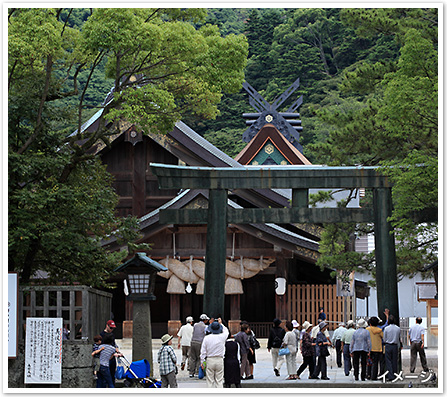
The land of Izumo is known as the land of gods and myths. In the land of Izumo, there are still many ancient shrines. And at the center of these shrines is Izumo Taisha which enshrines Okuninushi-no-Okami, who is familiarly known as Okuninushi-sama.
Izumo Taisha, famous as the god of matchmaking and good fortune, is an ancient shrine whose founding is recorded in the Kojiki, said to be the oldest historical book in Japan, and was called Kitsuki Taisha until the early Meiji period.
In the myth of the transfer of the country recorded in the Kojiki, Okuninushi-no-Mikoto handed over the country to Amaterasu-Omikami of Takamagahara, and the Amanohisumi-no-Miya Shrine built at that time is said to be the beginning of Izumo Taisha.
The large shimenawa rope at Izumo Taisha
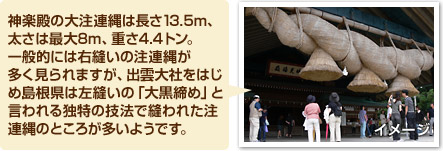
Click here for information on tours to Izumo Taisha
About Izumo Taisha 's largest religious ceremony, the Kamiari Festival
The eight million gods from all over Japan gather at Izumo Taisha to visit Okuninushi-no-Okami Oct. of the lunar calendar. In other regions, it is called "Kannazuki" (Month without Gods) because the gods are away, but in the Izumo region, it is called "Kamiari-zuki" (Month with Gods). At Izumo Taisha, where the gods gather, the festival begins with the "Kamimukaesai" (Welcoming the Gods Festival), followed by the "Kamiari-sai" (Festival to See the Gods Away), which sees the gods off to all parts of the country.
God's Welcome Ceremony

The Kamimukae Shinji ceremony to welcome the gods is held at Inasa Beach, the setting of the Kuniyuzuri myth. At 7pm, a sacred fire is lit on the beach, and in the hall covered with shimenawa ropes, seven sacred fences are set up, with a dragon and snake god beside them facing the sea to guide the gods.
After the ritual is over, the sacred shrine is covered on both sides with silk fences and, led by the Dragon and Snake God, worshippers follow, lined with tall lanterns and musical accompaniment, in a long procession that continues down the "Kamimukae no Michi" road from the beach to Izumo Taisha.
After this, the "Kamimukae-sai" (welcoming festival of the gods) is held at Izumo Taisha Kagura Hall by the kokuso (local governor) and all the other priests. After this, the gods are enshrined in the "Jukusha" (19 shrines) on the east and west, which are lodging (inn) shrines.
Kamiari Festival
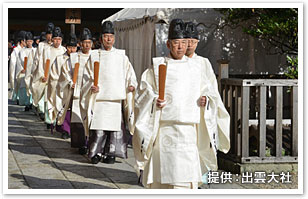
It is said that the gods of the whole country will hold a "Kami-agari" (divine council) in Izumo for seven days from the 11th to the 17th day of the lunar calendar (Oct.). In other words, they will decide various matters of life that cannot be known to humans in advance.
During the seven-day period of the gods' stay, "Kamu-no-Kagari" is held at the Kami-no-Miya (temporary shrine), located at Izumo Taisha, near Inasa Beach, to discuss various matters such as marriage between men and women and next year's harvest. Also, festivals are held every day at "Jyukusha" on both sides of the main shrine, Izumo Taisha, which serves as an oshuku-sha (an inn where the gods Accommodation stay).
Click here for tours to the Kamimukae Festival
* Place of departure buttons will be displayed below only for locations where tours are available.
Tours during the Kamiari Festival are available here
* Place of departure buttons will be displayed below only for locations where tours are available.
Izumo Taisha Shrine grounds map and worship route (example)
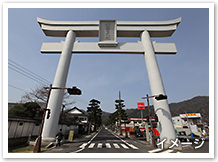
1. Great Torii Gate
This torii gate stands at the foot of Uka Bridge, halfway up the road from Seidamarizaka to the old Taisha Station. It is 23m high, 1m lower than the main hall Izumo Taisha, and made of reinforced concrete, with a circumference of 6m on the pillars and a diameter of 2m. The central frame is the size of a six-tatami mat room.
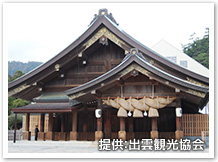
2. Worship Hall
It houses the worship hall, one of the largest wooden shrine buildings built after the war.
Usually, prayers are offered by worshippers, and various dedication ceremonies are held, including the traditional Niiname-sai festival.
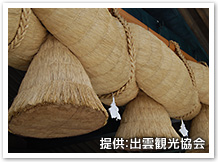
3. Kagura Hall and Shimenawa
The shimenawa at the Kagura Hall of Izumo Taisha is 13 meters long, 8 meters thick, and weighs 5 tons, making it one of the largest shimenawa in Japan. When you think of Izumo Taisha, many people will imagine the "Oshimenawa" at the Kagura Hall.
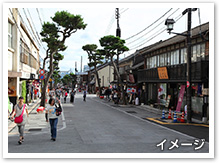
4. Shinmon Street
This street welcomes visitors to Izumo Taisha, and is lined with pine trees and restaurants serving Izumo soba and Izumo zenzai, as well as souvenir shops.
About group prayer
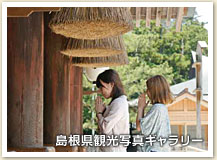
You will enter the Kagura Hall or worship hall and receive a prayer. One person on the tour will be chosen as the representative to make a tamagushi offering.
After watching the shrine maiden dance, everyone is given sacred sake and a charm.
Click here for group prayer tours at Izumo Taisha
About Izumo Taisha Torii

First Torii Gate
Shinmon Street
Pass under the majestic torii gate of Ukabashi Bridge and walk along Shinmon-dori street. The lively Omotesando approach is also worth a visit.
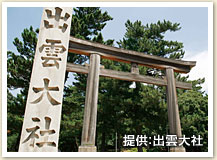
Second Torii Gate
Downward approach to the shrine
From the large torii gate at Seidamari, you can enter a rare downward approach to the shrine, which is the entrance to the world of divine power.
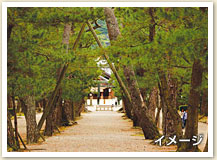
The third torii gate
Pine Approach
The rows of pine trees are over 400 years old. The solemn atmosphere prepares you for your visit.
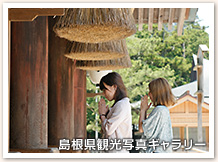
Fourth Torii Gate
Around the main hall
The main shrine where Okuninushi-no-Mikoto is enshrined is said to have been built in the Enkyo era (1744) and is a designated national treasure. At Izumo Taisha, the unique bow is performed: two bows, four claps, one bow.

